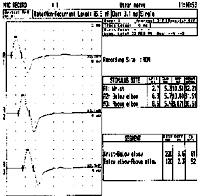1994 Project Reports | Contents | Previous | Next | Home |
Nerve Conduction Simulation for Electrodiagnostic Training
Charles G Burgar, MD; Kevin C McGill, PhD
Objective - This project assessed the feasibility of using computer simulation to replicate the physiological responses observed during clinical nerve conduction studies.
Nerve conduction studies (NCS) play an important role in the diagnosis of many neuromuscular disorders (e.g., nerve injuries, myasthenia gravis, muscular dystrophy, etc.). Learning to measure and interpret the evoked responses produced by electrical stimulation of peripheral nerves requires performance of the tests on several hundred patients under the supervision of an experienced clinician. Since the stimulation can be painful, use of a computer-based system to simulate responses from patients with various diseases (some of which are rare and may not be encountered during training) could result in more thorough and humane training of clinicians. This same system could be used to evaluate experimental NCS devices and software programs developed at this center in the future.
Approach - The electrical stimulus from a standard clinical electromyographic (EMG) instrument is digitized and analyzed in real time using a Lab-NB I/O board (National Instruments, Austin, TX) installed in an Apple Macintosh IIx computer. Pulse amplitude, duration and polarity determine the appropriate waveform to be selected from a library of signals obtained during actual clinical testing of patients with nerve and muscle pathology. Digital-to-analog conversion results in an accurate reproduction of the selected waveform. The reconstructed signal is applied to the input of the EMG instrument for display and analysis.
A LabVIEW (National Instruments) software package is used to collect signals for the waveform libraries. Attempts to implement the pulse analysis and waveform selection tasks in LabVIEW failed due to excessive computational delays. Software to successfully perform these tasks has been written in C and compiled as XCMD extensions to HyperCard.
Status - Selection of the desired simulation site (wrist, below elbow, or above elbow) determines the set of possible evoked responses (Figure 1). Feasibility of the approach has been documented by creating a sample case study which demonstrates the NCS findings characteristic of an ulnar nerve injury in the region of the elbow (Figure 2). Measurements of waveform latency, amplitude, nerve conduction velocity, etc., are then performed using standard clinical neurophysiological techniques.
  |
| Figure 1. Several sites of stimulation that can be simulated. |
 |
Figure 2. Waveforms simulating an ulnar nerve lesion at the elbow. |
Republished from the 1994 Rehabilitation R&D Center Progress Report. For current information about this project, contact Kevin C McGill.